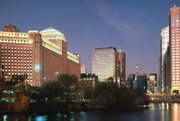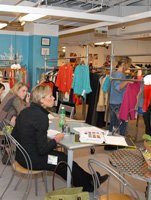Green Acres
Chicago’s Merchandise Mart takes the LEED in environmental consciousness
Greening a building is a challenge, especially if the edifice was erected 75 years ago, when “green” was synonymous with “chartreuse,” not “environmentally conscious.”
Now just imagine giving an eco makeover to the self-proclaimed world’s largest commercial building in the world. The Merchandise Mart in Chicago is two city blocks long and 4.2 million square feet in size and has nearly 150 bathrooms. And, yet, even a building of this size was able to win certification from the U.S. Green Building Council’s Leadership in Energy and Environmental Design (LEED) program.
The Merchandise Mart received its passing grade in November 2007 after a little more than two years of renovations and changes, virtually all of which were accomplished within the building’s existing operating budget.
The California Apparel News spoke with Marian Jarocki, vice president and assistant property manager of The Merchandise Mart, and Mark Bettin, vice president of engineering, about why and how they greened this mammoth building, and what others can do to lessen the environmental impact of their own buildings.
CAN: Tell us how this massive undertaking began.
MB: In 2005, we hired a consultant to critique how we’re operating in the building to find out whether we could even think about being LEED-certified. Being an established building, it was going to be a lot harder than a new development, where you’re choosing the proper pipes and lighting. Our building is 75 years old.
We found we had a lot of good programs in place—recycling, housekeeping and running equipment—but there were a lot of areas to build on. CAN: What was the most sobering news in your report card?
MB: Fortunately, I don’t think we were too far off. It was more [about] refining how we work in the building and even outside, where we changed to drought-resistant plants.CAN: What were some of the key changes you made?
MJ: For starters, we implemented new construction policies. This building has about 700,000 square feet of new construction per year. Now all cardboard is recycled, construction debris is separated, and construction spaces are barricaded off so particles don’t go into the air. And now low Volatile Organic Chemical paint is used.
We recycle batteries. We purchased a bulb crusher so our light bulbs are separated from the glass to keep the mercury out of the waste.
We also added a nonprofit Zipcar on the front drive for shared riding. We surveyed a large percentage of our tenants and found that 73 percent take some kind of public transportation or walk or ride a bicycle to work. This is so that if a tenant needs to run an errand, they can do it at very little cost and not have to drive to work. We have free bike stalls under the building so that if we get a sudden storm, they can leave their bikes safely under the building and take the bus home. We’re looking into scooter parking since we have more and more scooters because of gas prices.
In our bathrooms, we converted to environmentally friendly products and are now using cloth towels, which avoids the electricity used for dryers and the waste of paper towels. Even though they have to be laundered, there’s still less of an environmental impact.
CAN: What has been the biggest challenge, perhaps something you haven’t completed yet?
MB: With LEED certification, there’s quarterly reporting that will continue, and, about five years down the road, we’ll be up for recertification. Our recycling went up by 10 percent during the certification process by having more shift supervisors enforce recycling. So, for example, we’re looking to grow our recycling by another 10 percent.
MJ: And we just added in the past few months e-waste recycling of computers and calculators and such things. The challenge is educating ourselves and always finding something bigger and better.
At our trade shows—Stylemax [womenswear], the Men’s Show and the Bridal Show—we’ve started recycling in all the common areas, which we didn’t do before, even though we’re such a large recycler. All the paper they use is now recycled content, and we’re always looking for better ways to make banners and choose ink. CAN: Why was official LEED certification important to you? You could just as easily claim, “We greened the building.”
MB: The contract industry tenants in the building are going for their own certification in the same program, and if they’re in a certified building, it helps. That was one thing. We’re part of a large real estate company, and our parent company has a lot of desire to make all their buildings operate better and reduce their footprint. CAN: But what was the original motivation? Altruistic reasons, your efforts to help the planet, or are you seeing a cost savings?
MJ: All of the above. It’s good business. The tenants are younger, as well as the trade show attendees. So if you can come into a building that’s comfortable, with good air, and the lighting is great, then you work better. And it just makes good business sense to keep your tenants happy, who want to keep their employees happy. CAN: What type of budget do you need to go green?
MB: That’s tough to answer. We’ve always continued to mod-ernize the building, so there really was no new capital spent. In every area, we just tried to juggle within the existing budget. CAN: Are there immediate cost savings as a result of your efforts?
MB: Absolutely. With our exit signs, we went from a 20-watt light down to a 4. There are those kinds of savings from an energy standpoint. Overall, we’re trying to reduce the energy spent here by 20 percent. It’s a constant effort.
MJ: Our gift tenants switched their floodlights, which they normally use to light their showrooms, to fluorescent, and reduced their monthly electric bills by almost half. CAN: You mentioned air earlier. What are the issues involving air?
MB: During construction, it’s easy to kick up a lot of dust. Our policies here are stricter than they used to be. So, during remodeling, tenants put up barricades so there’s less chance of anything entering the HVAC system and migrating to other parts of the building. Same thing for products used to rebuild the space. You’re looking for formaldehyde-free products to keep the air quality as high as possible. We also monitor air quality throughout construction, as well as before and during trade shows.























